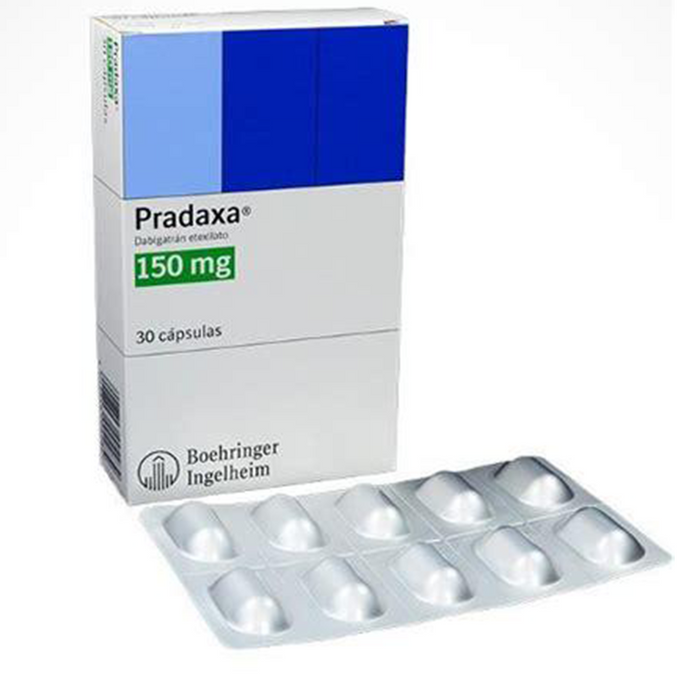Pradaxa: Health Benefits & Risks
What are the health benefits of Pradaxa?
Pradaxa (dabigatran) is an anticoagulant medication used to reduce the risk of stroke and blood clots in people with atrial fibrillation, a type of irregular heartbeat. It works by inhibiting the action of thrombin, a substance in the blood that is involved in the formation of blood clots. Some of the health benefits of Pradaxa include:
- Stroke prevention in atrial fibrillation: Pradaxa is highly effective in reducing the risk of stroke and systemic embolism in people with atrial fibrillation. Atrial fibrillation can cause blood to pool in the heart, increasing the risk of clot formation, which can lead to a stroke. Pradaxa helps prevent clot formation and reduces the risk of stroke in people with this condition.
- Treatment and prevention of deep vein thrombosis (DVT) and pulmonary embolism (PE): Pradaxa is used to treat and prevent DVT and PE, which are serious conditions that occur when a blood clot forms in a deep vein (usually in the leg) and can break loose and travel to the lungs. Pradaxa helps prevent the formation of new blood clots and reduces the risk of DVT and PE in people at risk.
- Lower risk of bleeding compared to warfarin: Pradaxa has been shown to have a lower risk of major bleeding compared to warfarin, a traditional anticoagulant medication. This can be beneficial for people who need anticoagulation therapy but are at higher risk of bleeding.
- Convenience of use: Pradaxa is taken orally, unlike some other anticoagulant medications that require regular injections. This can make it more convenient for people to take their medication as prescribed.
- Predictable anticoagulant effect: Pradaxa has a predictable anticoagulant effect, which means that regular monitoring of blood levels is not usually required. This can simplify treatment and reduce the need for frequent blood tests.
It’s important to note that while Pradaxa can be effective for many people, it may not be suitable for everyone. Pradaxa can cause side effects and may interact with other medications. It’s essential to consult with a healthcare provider before starting Pradaxa or any other medication to determine if it is the right choice for you.
What are the health risks of Pradaxa?
Pradaxa (dabigatran) is an anticoagulant medication that can be highly effective in reducing the risk of stroke and blood clots in certain conditions. However, like all anticoagulants, Pradaxa carries some health risks and potential side effects. It’s important to be aware of these risks and discuss them with your healthcare provider before starting treatment. Some of the health risks associated with Pradaxa include:
- Bleeding: Pradaxa can increase the risk of bleeding, including serious or life-threatening bleeding. This can occur in any part of the body, including the brain, stomach, intestines, and kidneys. The risk of bleeding may be higher in people with certain medical conditions, such as kidney disease, or in those taking other medications that increase the risk of bleeding.
- Gastrointestinal bleeding: Pradaxa has been associated with an increased risk of gastrointestinal bleeding, including bleeding ulcers. It’s important to seek immediate medical attention if you experience symptoms such as black, tarry stools; vomiting blood; or abdominal pain.
- Risk of stroke if stopped abruptly: Pradaxa should not be stopped abruptly without consulting a healthcare provider, as this can increase the risk of stroke or blood clots. It’s important to follow your healthcare provider’s instructions for stopping Pradaxa if necessary.
- Kidney function: Pradaxa is primarily eliminated from the body through the kidneys. In people with impaired kidney function, the risk of bleeding may be increased, and the dose of Pradaxa may need to be adjusted.
- Risk of heart attack: Some studies have suggested a possible increased risk of heart attack with the use of Pradaxa, especially in people with existing heart disease. However, more research is needed to confirm this association.
- Interaction with other medications: Pradaxa can interact with other medications, including certain antibiotics, antifungal medications, and medications that affect the kidneys. It’s important to inform your healthcare provider about all medications you are taking before starting Pradaxa.
- Other side effects: Common side effects of Pradaxa may include indigestion, stomach pain, nausea, and diarrhea. These side effects are usually mild and temporary but should be reported to your healthcare provider if they persist or worsen.
It’s important to discuss any concerns or questions about Pradaxa with your healthcare provider before starting treatment. Your healthcare provider can help determine if Pradaxa is the right choice for you and can monitor you for any potential side effects or health risks.
TL; DR: Pradaxa Summary
Pradaxa is a brand name for the prescription medication dabigatran, which belongs to a class of drugs known as direct oral anticoagulants (DOACs). It is an anticoagulant or blood thinner that is used to prevent blood clots and reduce the risk of stroke in individuals with certain heart conditions, particularly atrial fibrillation.
Pradaxa works by inhibiting the activity of thrombin, an enzyme involved in the blood clotting process. By preventing the formation of blood clots, Pradaxa helps reduce the risk of stroke and systemic embolism in individuals with atrial fibrillation.
Pradaxa is typically prescribed for individuals with non-valvular atrial fibrillation to reduce the risk of blood clots forming in the heart and causing a stroke. It may also be prescribed for the prevention and treatment of deep vein thrombosis and pulmonary embolism.
Pradaxa is available in capsule form, with the dosage and frequency of treatment determined based on the individual’s condition, medical history, and risk factors for blood clots.
Common side effects of Pradaxa may include gastrointestinal issues such as indigestion, nausea, and stomach pain. More severe side effects may include bleeding or bruising easily, signs of internal bleeding (such as blood in urine or stools), and allergic reactions. It is important to seek medical attention if you experience any severe or persistent side effects while taking Pradaxa.
Pradaxa can interact with other medications and substances, so it is important to inform your healthcare provider about any existing medical conditions or medications you are taking before starting treatment with Pradaxa. It is also essential to follow your healthcare provider’s instructions closely while taking Pradaxa and to attend regular follow-up appointments to monitor your response to treatment.
If you have any questions or concerns about taking Pradaxa, be sure to discuss them with your healthcare provider. It is important to seek medical advice if you have any concerns about your heart condition or experience any negative side effects while taking Pradaxa.




